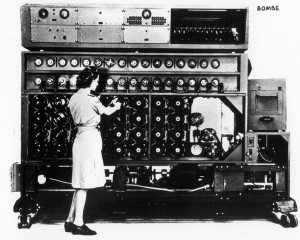 Last week I wrote about women in technology, a theme I’m continuing because there are so many women who played key roles in pioneering technologies, especially in early computing. This post is dedicated to all of my friends in the United Kingdom.
Last week I wrote about women in technology, a theme I’m continuing because there are so many women who played key roles in pioneering technologies, especially in early computing. This post is dedicated to all of my friends in the United Kingdom.
Cracking the Enigma Code
A recent TechRepublic article showcased the contributions of the British Government Code and Cypher School toward breaking the code of the German Enigma encryption machine during World War II. There were over 10,000 people working on this top-secret decryption effort, two thirds of whom were women. Many of them were just out of college or even just out of high school. Their job was to experiment with different decoding combinations that would crack messages being relayed by German command to the field. The decoding work went on in shifts, 24 hours a day. Every 24 hours the Germans changed the encryption algorithm so the British task started anew each day. The British needed a faster way to break the daily encryption code so that they could decode more messages.
Contributions to the Turing Machine
Alan Turing developed an electromechanical machine called the Bombe, which was designed to emulate several German Enigma encryption machines. While his invention did hasten the end of the war, it still took monumental human effort to configure it and run it each day. That task fell largely to the Women’s Royal Naval Service or the Wrens. Large drums had to be set from the front and boards had to be correctly plugged in the back, based on a menu or set of instructions for the day. The members of the Code and Cypher School, including the Wrens, worked in eight-hour shifts, often changing shifts weekly. Their mission was top secret, so they were not able to tell their families about their work. Because of this secrecy, many of these women and men were not given the credit they deserved until much later, if at all.
Pioneers in Computing
In the early days of computing, women in America were calculating ordnance and trajectory tables using simple electromechanical calculators, while women in Britain were programming the very earliest electromechanical computers to decrypt messages from the Allied enemies. Both were involved in early computing and both were on a common mission to aid the Allies in winning the war. From these experiences came a pressing need to automate work and speed up calculations. The earliest electromechanical computers gave way to the first digital computers, and thankfully they became employed in business and commerce instead of war.
Thoughts
When you open your laptop or turn on your tablet or smartphone, I hope that you will consider the contributions of women and men in early computing. Room-sized computers have given way to pocket-sized devices, but not overnight and not without a lot of effort. It has been an incredible history and I look forward to the future.
 About Kelly Brown
About Kelly Brown
Kelly Brown is an IT professional and assistant professor of practice for the UO Applied Information Management Master’s Degree Program. He writes about IT and business topics that keep him up at night.
